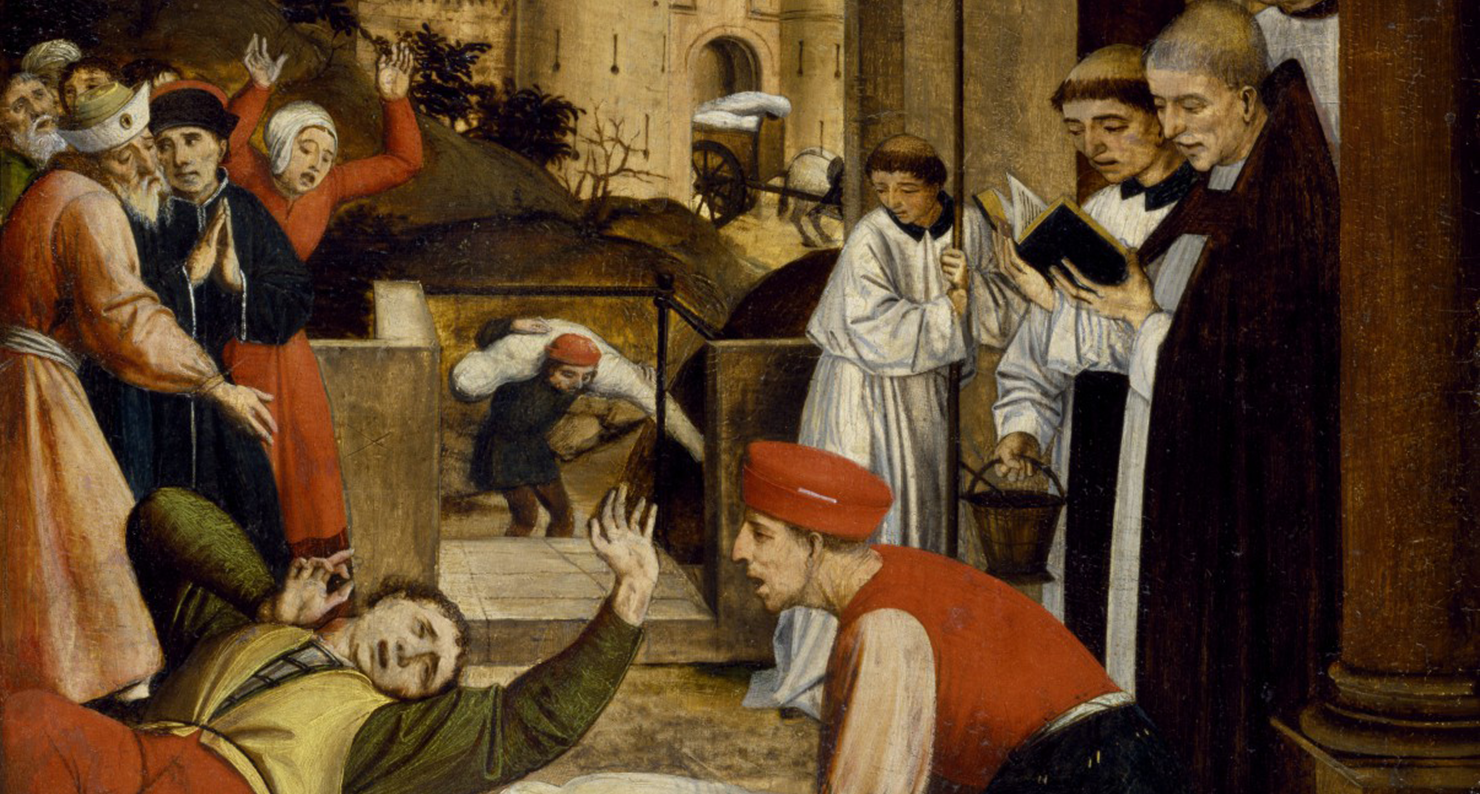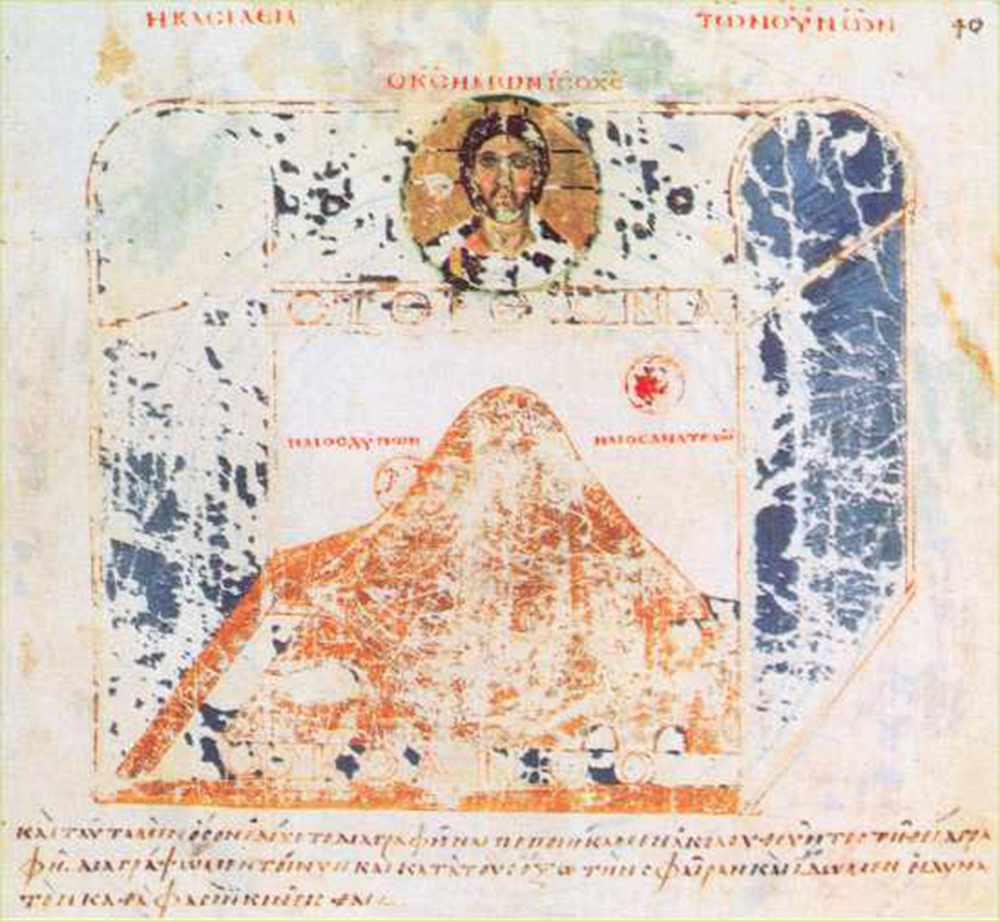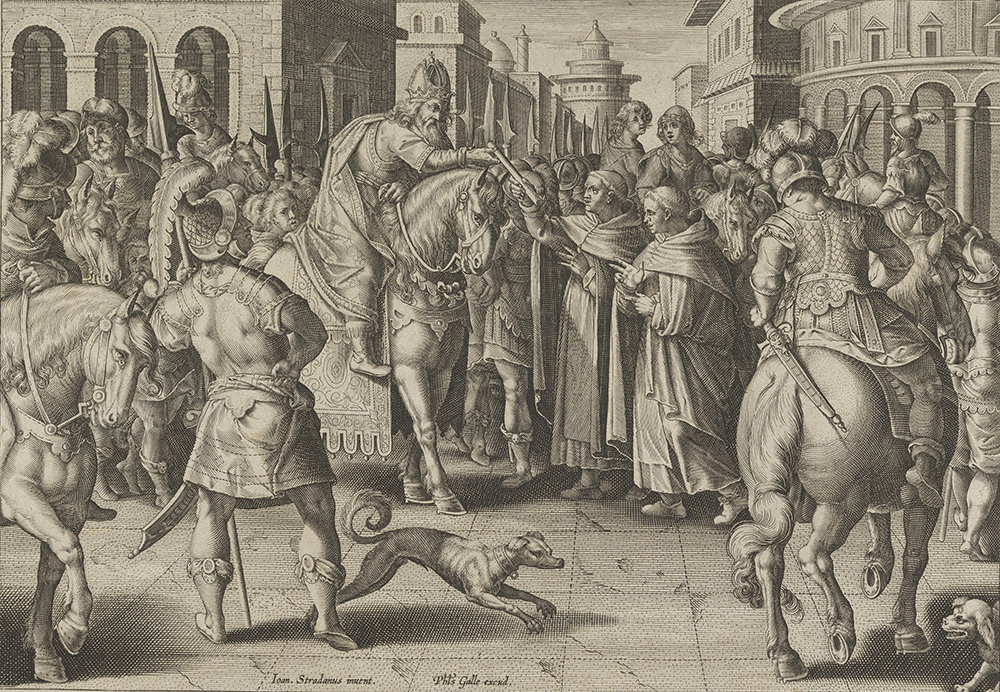
Saint Sebastian Interceding for the Plague Stricken (detail), by Josse Lieferinxe, c. 1497–99. Walters Art Museum.
In his Christian Topography, the sixth-century trader known as Cosmas Indicopleustes relayed the belief, held by the Brahman philosophers of India, that if you were to stretch a string from China to Rome, it would run through Persia and bisect the world. From the vantage of Cosmas, China, the “land of silk,” was “beyond furthest India,” at the opposite end of the earth. The shortest route might lay overland, through Persia. “That is why there is always found an abundance of silk in Persia.” But for Cosmas, the more familiar passage to the far east was clearly across the waters. China was “toward the left part for those entering the Indian sea,” past the Persian Gulf, beyond “Taprobane,” our Sri Lanka. Cosmas knew the commerce in silk impelled men to journey to “the ends of the earth.” In the sixth century, the ends of the earth were drawn together on threads of silk.
“Cosmas Indicopleustes” means Cosmas the Voyager to India. This was not his real name. He may never even have been to what we call India. Medieval scribes bestowed the name on a writer who called himself simply “a Christian.” More important, India in late antiquity was a rather broader concept than we are used to. It referred indiscriminately to the lands ringing the Indian Ocean, from Ethiopia to India proper. All that we know about Cosmas derives from his own writings. He was a merchant in Alexandria who worked the Red Sea trade; he had traveled far and wide. He claimed to have sailed three seas—the Mediterranean, Red, and Persian. He had certainly voyaged through Ethiopia, where he transcribed a historic inscription and saw a wild rhinoceros. Cosmas was scrupulously honest, and he nowhere claimed to have traveled the subcontinent. But his Christian Topography is a prime artifact of the interconnected Indian Ocean world in late antiquity.
After a lull in the third century, Roman trade in the Red Sea and Indian Ocean rebounded in late antiquity. Berenike remained a bustling entrepôt. The twin ports at the northern end of the Red Sea, at Clysma (at Suez) and Aila, seem only to have grown in importance. The southern end of the Red Sea, on either side of the straits at the Bab-el-Mandab, was a hot zone of geopolitical tension. The powerful Axumite Kingdom in Ethiopia stared across at the rival kingdoms of southern Arabia. The contrast between Roman consumer demand, on the one hand, and the deficit of Roman power, on the other, was a fact of life for traders in the Indian Ocean. The Romans could barely control the Red Sea, their watery backyard. Power projection into the ocean beyond was simply beyond the means of the empire. As Cosmas candidly describes, the Red Sea trade connected the Romans to a wild and woolly world of adventurous traders and minor potentates. The Romans were players with a strong sense of their own civilizational superiority, but no on-the-spot advantages. Cosmas knew a maritime zone of exchange shared by Greeks, Ethiopians, Arabs, Persians, and Indians.

The Christian Topography marshaled practical information about the movement of people, goods, and ideas. Pepper and silk were the prized articles of exchange. The spice trade remained big business in late antiquity. We have the haphazard fact that Constantine’s donations to the Church of St. Peter’s in Rome included 755 pounds of pepper—per year. The remarkable eleventh book of The Christian Topography even included passable sketches of the pepper tree.
Alongside the trade in spices, silk had become big business by late antiquity. Silk was synonymous with China, where the secrets of the silkworm were closely guarded. The Romans imported silk over land and across the southern seas. The state was a promiscuous consumer, but aristocratic and ecclesiastical demand fueled the private market too. The importance of the silk trade is measured by its political dimensions. It is hard to think of another commodity that assumed real geopolitical importance in Roman history. In late antiquity, the silk trade had global clout. The Persians used it as leverage. Justinian actively sought to control or circumvent the trade. Late in his reign, Christian monks from India, who had “spent much time in a land situated far to the north of the nations of India which is called ‘Serinde,’” i.e., China, offered to betray the secrets of silk production and smuggle unhatched silkworm eggs from the east. They were dispatched to China and made the return, and “from that time onward silk has been produced in the lands of the Romans.” Only chemical analysis of Byzantine silks will eventually reveal if this act of daring corporate espionage was really successful.
Silk and pepper were complemented by an array of trade goods that filled cargoes moving across the ocean. Ivory and aromatics, aloe, cloves, clove-wood, sandalwood, gold, and slaves were all part of the trading system known to Cosmas. Slaves were not a negligible commodity. Chattel slaves have been mostly invisible in modern histories of the trade, but Cosmas casually assumed that “most slaves” imported into the Roman Empire came from Ethiopia. And, more ethereally, ideas moved across the waters. Christians (many originating from Persia) enjoyed missionary success throughout the east. Indian forms of philosophy and asceticism continued to fascinate and draw seekers. An India of the mind, peopled by otherworldly sages, was carried back to the west.
The real scale of this commerce eludes us. The Romans fought to control an island in the Red Sea where the state levied a toll on imports from India. The revenue was described as “massive.” The scattered finds of late Roman coins in India stretch from the fourth century down to the reign of Justinian. Maybe most revealing of all is the sudden importance of the Red Sea theater in the alternating phases of cold and hot war between the Romans and Persians. The Christian Axumite Kingdom of Ethiopia was ascendant in the early sixth century. The Himyarite Kingdom of south Arabia converted to Judaism—of an unusually militant stripe. Religious animus stoked ancient rivalry, and in 525 the Axumites invaded the Himyarite kingdom with Roman military aid. The conflict drew in the great powers. Over the next two decades, the Ethiopians and Himyarites were clients of the Romans and Persians. A generation later, Muhammad was born into this world, which has now been evocatively described as the “crucible of Islam.” Religion, politics, and commerce intertwined to make this region strategically valuable. The Romans were keen to maintain a stable bridgehead into the waters beyond.
Consumer demand for silk and spices drew together east and west. Ideas and animals, money and metals, moved across the seas. So, too, came germs. In 541 an unwelcome stowaway was smuggled into the empire from the world beyond. No one who has read the sources closely denies that the Justinianic Plague first appeared in Egypt. Our star witness, Procopius, pinpointed the origin of the outbreak in Pelusium. John of Ephesus, who was on the scene in Alexandria when it appeared there, claimed that it came “from the regions to the southeast of India, of Kush, the Himyarites, and others.” The dispersal from Pelusium, in combination with the genetic evidence of the plague’s eastern origins, guarantees an Indian Ocean passage for the first plague pandemic. Pelusium lay due north of the port of Clysma, a primary terminus of Red Sea trade. Ships all the way from India were docked at its port. From Clysma, Pelusium was a short leap. It was only a few days’ journey overland or a short sail down the old Canal of the Pharaohs, rebuilt by Trajan, connecting Clysma to the Nile just upriver from Pelusium. The first pandemic made its debut right at the hinge of the empire and the Indian Ocean world.

It required one last twist of fate for the bacterium to make its grand entrance into the Roman world. The Asian uplands had prepared a monster in the germ Y. pestis. The ecology of the empire had built an infrastructure awaiting a pandemic. The silk trade was ready to ferry the deadly package. But the final conjunction, what finally let the spark jump, was abrupt climate change. The year 536 is known as a “Year without Summer.” It was the terrifying first spasm in what is now known to be a cluster of volcanic explosions unmatched in the last three thousand years. Again in 540–41 there was a gripping volcanic winter. The 530s and 540s were not just frosty—they were the coldest decades in the late Holocene. The reign of Justinian was beset by an epic, once-in-a-few-millennia cold snap, global in scale.
The climate disturbance in the moments preceding the Plague of Justinian is a sudden, blinding flash that we instinctively know must be connected to the crash that immediately follows. We do not know just exactly how the one caused the other. A plague epidemic is a chain reaction involving at least five different species. It is a great biological domino event, encompassing the bacterium, the sylvatic host (e.g., marmots), the amplification host (the black rat), the arthropod vector (the oriental rat flea), and us. Minute changes in temperature and precipitation can affect the habitats, behavior, and physiology of each organism involved in the cycle. Still today, small vibrations in the climate trigger visible effects on plague cycles in rodent populations. Even within the relatively small bounds of year-to-year variability, the climate is a governor on the heat of enzootic plague.
One thing is certain: the relation between climate and plague is not neat and linear. As with so many biological systems, it is marked by wild swings, narrow thresholds, and frenzied opportunism. Rainy years foster vegetation growth, which in turn sparks a trophic cascade in rodent populations. In excess, water can also flood the burrows of underground rodents and send them scurrying for new ground. Population explosions stir the emigration of rodents in search of new habitats. Today, there is a strong connection between El Niño and the outbreak of plague in China. It is entirely likely that these relationships held into the Holocene past. Given that there is a strong correlation between volcanism and El Niño, the volcanic eruptions of the 530s may have stirred the Chinese marmots or gerbils carrying Y. pestis out of their familiar subterranean colonies, triggering an epizootic that reached the rodents of the seaborne trade routes heading west. Altogether, the most likely scenario is that the climate patterns of the early sixth century brought greater rain to the semiarid homelands of the reservoir species; vegetative growth sparked a demographic explosion of burrowing rodents, and Y. pestis spilled into new host populations.
The climate also regulates the plague by acting on the fleas that carry the bacterium between hosts. The sensitivity of the flea to ambient temperatures creates the basic seasonal pattern of plague. The flea is picky about reproducing within a certain band of temperature. And the fatal blockage in its gut that causes it to regurgitate infected blood is preciously averse to temperatures that are too low or too high. The familiar result is a seasonally specific plague cycle. Epidemics gain momentum in the spring. But the high heat of summer can suddenly squelch the outbreak. In early twentieth-century India, the oppressive heat of late summer knocked down the incidence of bubonic plague to virtually nil. The sharp cooling of the 530s and 540s may have opened geographical possibilities that Y. pestis had never seen. Mild summers might have opened the gates across the balmy southern passage. The mean temperatures along the Spice Coast fall precisely along the threshold of what the plague cycle will tolerate.
The precise sequence of events that caused the plague to spill out of its mountainous haunts and to explore new routes across the southern waters is likely to stay just beyond our grasp. Through the shadows we sense the enormous contingency of the fatal moment. The alignment of natural history and human history in the making of this moment baffles our distinctions between chance and structure. What we can say is that the deadly germ found its way, perhaps by the slimmest of margins, to the rats of the Roman Empire.
Excerpted from The Fate of Rome: Climate, Disease, and the End of an Empire by Kyle Harper. Copyright © 2017 by Princeton University Press. Reprinted by permission.